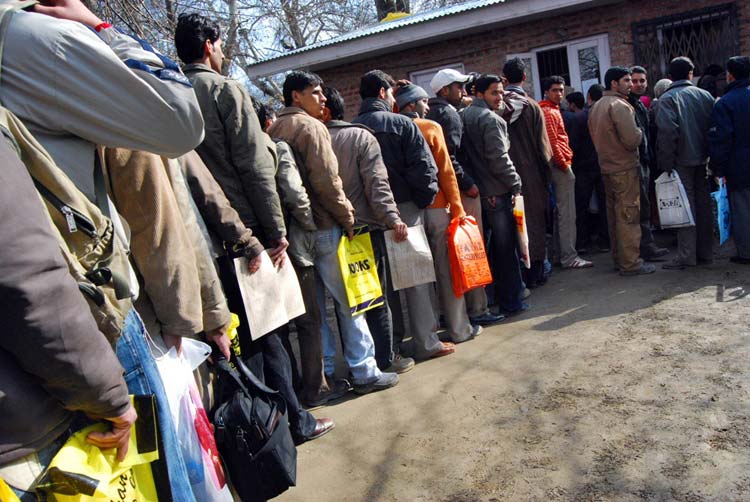
AS per India’s leading business Information Company, Centre for Monitoring Indian Economy (CMIE), J&K’s unemployment ratio as on October 2020 hovered at around 16 percent. This is way above the all India average of 6.98 percent for the same period. In terms of absolute value, J&K is therefore currently crowded with a staggering number of approximately 7.5 Lakh unemployed people. The actual situation on ground, however, is much worse than what the sample survey based CMIE has estimated-as envisaged in this column (J&K’s employment drought 5th Sep 2020). As a matter of established fact, this poor performance on account of employment in J&K is not a new phenomenon and is surely not driven by the prevailing pandemic alone. A quick view of the monthly unemployment rates in J&K on CMIE platform depict a continuously dismal performance throughout the past 48 months, with unemployment rates even touching 30 percent at times.
Logically, the situation of unemployment arises when the number of available manpower exceeds the volume of jobs available in the market. However, the same economy where lakhs of indigenous workers are unable to find jobs, paradoxically, provides secure stable and consistently growing livelihood to lakhs of migrant labor force with fair amount of efficiency. This conundrum of employment irony is what is referred to as an “Employment Paradox” and is definitely not unique with our economy.
How much do non-local workers earn?
Various Govt and private estimates regarding the number of migratory labor force working in J&K has put the number between a range of 5 Lakh to 10 Lakh. Barring the climatically hostile months of December and January, most of these workers spend around 300 days in J&K from February till November. Their daily wage ranges from Rs. 600 to Rs. 1200 depending upon the skill level and the nature of job. Pertinently, these rates are 40-50 percent higher than what they normally earn in their home states of Bihar, UP, Rajasthan, West Bengal etc. From toiling unskilled construction workers and agrarian laborers, these migrant workers over a period of decades have gradually cemented their way into more skillful and high earning roles in manufacturing plants, tailoring shops, salons, gymnasiums, restaurants, masonry, carpentry, tiling and even gold smithing. Add to this their prolific growth in trading sector as well. Door to door selling of textiles, blankets and scores of migrant hawkers selling street food & road side merchandise can be witnessed across the region.
Assuming 75% of working days (225 days) at an average daily wage of Rs. 700 across the skill spectrum, a conservative number of five Lakh migrant laborers skim a fortune of Rs. 7875 Crore annually from J&K. To put things into perspective, this is almost equal to our flagships Apple, Walnut and Saffron industries put together, which support over 7 Lakh families in the region. This entire earning pie gets normally divided in two parts. A typical ratio of 60% saving (transferred to their families back home) and 40% on local consumption (on rentals, conveyance and food), is followed. In other words, it means an annual flight of approximately Rs. 4725 crore and a domestically created demand of around Rs. 3150 Crore.
Why are local workers not competing in this segment?
Despite chronic regional unemployment, the local market forces have been more than willing to let the trend continue. Why has this issue never became a part of the political debate in J&K? The answer is surprisingly simple – nobody actually wants these jobs. This economically ironic behavior is surely not without an explanation and there are a host of social as well as economic reasons for this employment conundrum.
Firstly, the disruption caused in the categorization of economic classes in 1950, when land was distributed evenly among peasants and landlords blurred class lines. This iconic decision resulted in an economically homogeneous society with majority of the people lying somewhere in the middle of the income bell curve. Land ownership has been a great leveler and this is why even today after almost seven decades, the below poverty ratio in J&K at 10.35% is less than half of all India average of 21.92 %. This is precisely the reason why it is very difficult for us to find indigenous workers for lower strata jobs in the economy.
Secondly, due to comparatively blurred levels among social classes, the education levels among generations too have been almost at par with minor inequality. With vast majority of workforce carrying respectable academic credentials, the expectations for an office going white collar job too have been acting as a spoil sport. We have examples where people have preferred a Rs. 1500 per month RET job rather than earning almost 10 times more in the open market.
Thirdly, there has been a growing chasm of skill mismatch. While our educational institutions have been awarding diplomas and degrees to growing number of youth, the stress has mostly been on theoretical aspects – unfortunately even in technical courses. Ideally, the skilled and technical human resource requirement of an economy is supplied by ITIs and Polytechniques. We do have both these supply chains established long back with numerous employees and branches spanning across the region but somehow it seems that they have lost the plot. What they train is obsolete and what is demanded is absent. Despite our manufacturing & construction sector creating decent salaried jobs, the skill starved youth are finding it difficult to compete with experienced migrant workers in this segment.
Without a doubt, the sustained political conflict has been the main building block around which these structural flaws have emerged. The backwardness of our industry and private sector which has forced it to remain small and primitive has resulted in very elementary levels of job creation. The impact on our technical and vocational skill centers too has been severe. Operating within an environment of frequent restrictions on physical movement and sustained communication shut down have resulted in chronic down gradation of the regional private sectors’ ability to soak middle income level employment. As a natural response, job seekers and likewise the educational sector adjusted negatively.
Poverty is a great influencer but so is social approval and perception of dignity. With time the stereotype constructed by the economically backward migrant workers in construction, orchards and brick kilns, the stigma of rubbing shoulders with such class of laborers at work erected huge social barriers even among people who are desperately in need of earnings. There is a tacit structural hierarchy of work and migrant laborers are being perceived at the lowest step of the work ladder. This is why we see local farmers paying Rs. 600 per day to migrant workers in their paddy fields and orchards so that they can spare themselves to work in a contractual Govt job at Rs. 225 per day. This is beyond financial loss and gain for them. This is more about gaining social equity.
Nevertheless, things are changing fast. The sustained economic shocks are pushing more indigenous people below the poverty line and the skill sets needed for new jobs is changing fast. Moreover, the migrant labor force has slowly but growingly been competing in more skill based sectors. How these fast changing dynamics will govern the job markets in future will determine the fate of this paradox. We can only hope that timely policy interventions and effective responses from job seekers change the situation for better.
The views expressed in this article are author’s own and do not necessarily represent that of Kashmir Observer
Follow this link to join our WhatsApp group: Join Now
Be Part of Quality Journalism |
Quality journalism takes a lot of time, money and hard work to produce and despite all the hardships we still do it. Our reporters and editors are working overtime in Kashmir and beyond to cover what you care about, break big stories, and expose injustices that can change lives. Today more people are reading Kashmir Observer than ever, but only a handful are paying while advertising revenues are falling fast. |
| ACT NOW |
| MONTHLY | Rs 100 | |
| YEARLY | Rs 1000 | |
| LIFETIME | Rs 10000 | |










